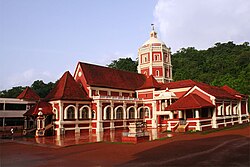Shanta Durga Temple: Difference between revisions
(→Deity) |
(robot: Update article (please report if you notice any mistake or error in this edit)) |
||
| Line 15: | Line 15: | ||
|country = [[India]] | |country = [[India]] | ||
|state = [[Goa]] | |state = [[Goa]] | ||
|locale = [[ | |locale = [[Kavale]], [[Ponda, Goa|Ponda]], [[South Goa]] | ||
|elevation_m = | |elevation_m = | ||
|website = http://shreeshantadurga.com/ | |website = http://shreeshantadurga.com/ | ||
| festivals=Magh Shuddha Panchmi (Jatrautsav), Navaratri | |festivals= Magh Shuddha Panchmi (Jatrautsav), Navaratri, | ||
5 Mahapanchmi. | |||
|Date established = 1738 | |||
}} | }} | ||
'''Shri Shantadurga Saunsthan''' is a private temple complex belonging to the Goud Saraswat Brahman Samaj | |||
'''Shri Shantadurga Saunsthan''' is a private temple complex belonging to the Goud Saraswat Brahman Samaj located {{convert|30|km|0|abbr=on}} from [[Panaji]] at the foothill of [[Kavale]]m village in [[Ponda taluk|Ponda Taluka]], [[Goa]], [[India]]. | |||
Shrimad Swamiji of Shri [[Kavale Math]] is spiritual head Of Shree Shantadurga Saunsthan, Kavale (Shrimat Shivananda Saraswati Swami Gauḍapādāchārya of Shri [[Kavale Math]] is spiritual chief Of Shree Shantadurga Saunsthan). | |||
Shree Shantadurga is the [[Kuldevta|Kuldevi]] (family deity) of many Goud Saraswat Brahman | Shree Shantadurga is the [[Kuldevta|Kuldevi]] (family deity) of many Goud Saraswat Brahman. | ||
On 4 December 2016, (Margashirsh Shuddh Panchmi). Shree Shantadurga Devasthan, Kavale has completed its 450th year of existence. | On 4 December 2016, (Margashirsh Shuddh Panchmi). Shree Shantadurga Devasthan, Kavale has completed its 450th year of existence. | ||
| Line 34: | Line 37: | ||
Shantadurga is holding two [[Serpent (symbolism)|serpents]], one in each hand, representing Vishnu and Shiva. | Shantadurga is holding two [[Serpent (symbolism)|serpents]], one in each hand, representing Vishnu and Shiva. | ||
Shrimat Shivananda Saraswati Swami Gauḍapādāchārya of Shri [[Kavale Math]] is spiritual head of Shree Shantadurga Saunsthan, Kavale. | |||
==Temple== | ==Temple== | ||
The original temple at [[Quelossim]] (Keloshi) in [[Salcete]] was destroyed by the Portuguese in 1566. The goddess was shifted to Kavalem and worship was continued there. The site on which the original Temple of Shantadurga stood at Quelossim (Keloshi) is known as "Deoolbhata" and it is in the possession of the Shree Shantadurga Saunsthan Committee, Kavale. | The original temple at [[Quelossim]] (Keloshi) in [[Salcete]] was destroyed by the Portuguese in 1566. The goddess was shifted to Kavalem and worship was continued there. The site on which the original Temple of Shantadurga stood at Quelossim (Keloshi) is known as "Deoolbhata" and it is in the possession of the Shree Shantadurga Saunsthan Committee, Kavale. | ||
The current temple was constructed during the reign of [[Maratha Empire]][[Chattrapati Shahu]] Maharaj of [[Satara State|Satara]] during the period from 1713 AD to 1738 AD. Naroram Mantri(Rege) originally from Kochara village in the Vengurla Taluka,(Konkan) was a ''Mantri'' (Minister) in Chattrapati Shahu Maharaj(Grandson of Chh.Shivaji Maharaj & Son of Dharmaveer Chh.Sambhaji Maharaj)Ashtapradhan Mandal at Satara Due to his efforts, the village of Kavalem was bequeathed to the Temple by Shrimant [[Baji Rao I]] Peshwa in 1738. | The current temple was constructed during the reign of [[Maratha Empire]] [[Chattrapati Shahu]] Maharaj of [[Satara State|Satara]] during the period from 1713 AD to 1738 AD. Naroram Mantri(Rege) originally from Kochara village in the Vengurla Taluka,(Konkan) was a ''Mantri'' (Minister) in Chattrapati Shahu Maharaj(Grandson of Chh.Shivaji Maharaj & Son of Dharmaveer Chh.Sambhaji Maharaj)Ashtapradhan Mandal at Satara Due to his efforts, the village of Kavalem was bequeathed to the Temple by Shrimant [[Baji Rao I]] Peshwa in 1738. | ||
The Temple reconstruction started around 1730s. | The Temple reconstruction started around 1730s. | ||
The temple complex is on the slope of the foothills of a mountain chain, surrounded by lush vegetation. There is a main temple and three smaller temples of other deities which have been built on three sides of the temple. The temple consists of a collection of pyramidal roofs with a dome. The pillars and floors are made of [[Kashmir]] stone. The temple has a huge [[Irrigation tank|tank]], a [[Deep Jyoti Stambh|Deepastambha]] and ''agrashalas'' (guest houses). | The temple complex is on the slope of the foothills of a mountain chain, surrounded by lush vegetation. There is a main temple and three smaller temples of other deities which have been built on three sides of the temple. The temple consists of a collection of pyramidal roofs with a dome. The pillars and floors are made of [[Kashmir]] stone. The temple has a huge [[Irrigation tank|tank]], a [[Deep Jyoti Stambh|Deepastambha]] and ''agrashalas'' (guest houses). | ||
| Line 45: | Line 48: | ||
==Architectural Styles== | ==Architectural Styles== | ||
This Temple is built in Saraswat Architectural style. | |||
Its pyramidical shape 'shikaras' rising on the roofs of the facade (entrance hall) and the 'Sabhamandap' (the main hall), its roman-arched windows, some of which have the stained-glass window panes of deep red, yellow, blue, green colours, its chandeliers, its gate posts, balustraded flat dome, the maroon-peach-white colour paint of the temple gives the temple a serene beautiful look. | Its pyramidical shape 'shikaras' rising on the roofs of the facade (entrance hall) and the 'Sabhamandap' (the main hall), its roman-arched windows, some of which have the stained-glass window panes of deep red, yellow, blue, green colours, its chandeliers, its gate posts, balustraded flat dome, the maroon-peach-white colour paint of the temple gives the temple a serene beautiful look. | ||
| Line 59: | Line 63: | ||
File:Inside the Shantadurga Temple, Ponda, Goa.jpg|An Elaborate Rangoli inside the Temple during Shatakalash puja. | File:Inside the Shantadurga Temple, Ponda, Goa.jpg|An Elaborate Rangoli inside the Temple during Shatakalash puja. | ||
File:Shri Shantadurga Temple.jpg|Shri Shantadurga Temple from front | File:Shri Shantadurga Temple.jpg|Shri Shantadurga Temple from front | ||
File:Deepasthamba at the Shantadurga Temple in Kavale, Ponda, Goa.jpg|Deepastambha at Shri Shantadurga Temple | |||
</gallery> | </gallery> | ||
==See also== | ==See also== | ||
{{columns-list|colwidth=30em| | {{columns-list|colwidth=30em| | ||
*[[Mangueshi Temple]] | |||
*[[Temples of Goa]] | *[[Temples of Goa]] | ||
*[[Shri Gaudapadacharya Math]] | *[[Shri Gaudapadacharya Math]] | ||
*[[Kavale]] | *[[Kavale]] | ||
*[[Mangeshi Village]] | *[[Mangeshi Village]] | ||
*[[Shantadurga Kalangutkarin Temple]] | *[[Shantadurga Kalangutkarin Temple]] | ||
}} | }} | ||
| Line 81: | Line 86: | ||
*[https://web.archive.org/web/20071209110407/http://www.goacom.org/pictures/drga.html Photo of Shanta Durga Temple] | *[https://web.archive.org/web/20071209110407/http://www.goacom.org/pictures/drga.html Photo of Shanta Durga Temple] | ||
*[https://web.archive.org/web/20091026053545/http://geocities.com/ggavaska/manydurga.html Other Durga-Shantadurga Temples] | *[https://web.archive.org/web/20091026053545/http://geocities.com/ggavaska/manydurga.html Other Durga-Shantadurga Temples] | ||
*[https:// | *[https://web.archive.org/web/20011203075549/http://www.geocities.com/ggavaska/othernava.html Navadurga Temples] | ||
{{Hindu temples in Goa}} | {{Hindu temples in Goa}} | ||
| Line 87: | Line 92: | ||
{{DEFAULTSORT:Shanta Durga Temple}} | {{DEFAULTSORT:Shanta Durga Temple}} | ||
[[Category:Durga temples]] | [[Category:Durga temples]] | ||
[[Category:Hindu temples in | [[Category:Hindu temples in South Goa district]] | ||
Latest revision as of 09:09, 26 June 2022
| Shanta Durga Temple | |
|---|---|
| Religion | |
| Affiliation | Hinduism |
| Deity | Shantadurga |
| Festivals | Magh Shuddha Panchmi (Jatrautsav), Navaratri, 5 Mahapanchmi. |
| Location | |
| Location | Kavale, Ponda, South Goa |
| State | Goa |
| Country | India |
| Geographic coordinates | 15°23′45″N 73°58′04″E / 15.3958323°N 73.9677682°ECoordinates: 15°23′45″N 73°58′04″E / 15.3958323°N 73.9677682°E |
| Website | |
| http://shreeshantadurga.com/ | |
Shri Shantadurga Saunsthan is a private temple complex belonging to the Goud Saraswat Brahman Samaj located 30 km (19 mi) from Panaji at the foothill of Kavalem village in Ponda Taluka, Goa, India.
Shrimad Swamiji of Shri Kavale Math is spiritual head Of Shree Shantadurga Saunsthan, Kavale (Shrimat Shivananda Saraswati Swami Gauḍapādāchārya of Shri Kavale Math is spiritual chief Of Shree Shantadurga Saunsthan).
Shree Shantadurga is the Kuldevi (family deity) of many Goud Saraswat Brahman.
On 4 December 2016, (Margashirsh Shuddh Panchmi). Shree Shantadurga Devasthan, Kavale has completed its 450th year of existence.
Deity[edit]
The temple is dedicated to Shantadurga, the goddess who mediates between Vishnu and Shiva. The deity is also called 'Santeri' colloquially. Purana talks of a battle between Shiva and Vishnu The battle was so fierce that the God Brahma prayed to Goddess AdishaktiParvati to intervene, which she did in the form of Shantadurga. Shantadurga placed Vishnu on her right hand and Shiva on her left hand and settled the fight.
Shantadurga is holding two serpents, one in each hand, representing Vishnu and Shiva. Shrimat Shivananda Saraswati Swami Gauḍapādāchārya of Shri Kavale Math is spiritual head of Shree Shantadurga Saunsthan, Kavale.
Temple[edit]
The original temple at Quelossim (Keloshi) in Salcete was destroyed by the Portuguese in 1566. The goddess was shifted to Kavalem and worship was continued there. The site on which the original Temple of Shantadurga stood at Quelossim (Keloshi) is known as "Deoolbhata" and it is in the possession of the Shree Shantadurga Saunsthan Committee, Kavale. The current temple was constructed during the reign of Maratha Empire Chattrapati Shahu Maharaj of Satara during the period from 1713 AD to 1738 AD. Naroram Mantri(Rege) originally from Kochara village in the Vengurla Taluka,(Konkan) was a Mantri (Minister) in Chattrapati Shahu Maharaj(Grandson of Chh.Shivaji Maharaj & Son of Dharmaveer Chh.Sambhaji Maharaj)Ashtapradhan Mandal at Satara Due to his efforts, the village of Kavalem was bequeathed to the Temple by Shrimant Baji Rao I Peshwa in 1738. The Temple reconstruction started around 1730s. The temple complex is on the slope of the foothills of a mountain chain, surrounded by lush vegetation. There is a main temple and three smaller temples of other deities which have been built on three sides of the temple. The temple consists of a collection of pyramidal roofs with a dome. The pillars and floors are made of Kashmir stone. The temple has a huge tank, a Deepastambha and agrashalas (guest houses).
Many renovations have been completed over the years to the main temple and the temples of the other deities as well as to the agrashala. The temple has recently banned entry of foreigners into the temple citing objectionable dressing and conduct as the reason.[1]
Architectural Styles[edit]
This Temple is built in Saraswat Architectural style. Its pyramidical shape 'shikaras' rising on the roofs of the facade (entrance hall) and the 'Sabhamandap' (the main hall), its roman-arched windows, some of which have the stained-glass window panes of deep red, yellow, blue, green colours, its chandeliers, its gate posts, balustraded flat dome, the maroon-peach-white colour paint of the temple gives the temple a serene beautiful look.
The highlight of the temple is its golden palanquin (palkhi) in which the deity is carried on festive occasions (only 5 Mahapanchmi).[citation needed]
Gallery[edit]
| Part of a series on |
| Hinduism |
|---|
 |
- Entrance to ShantaDurga Temple.jpg
Entrance to the Shri ShantaDurga Saunsthan.
The Deepa Stambha of the temple
- Shanta Durga Temple Complex Lake.jpg
Shanta Durga Temple Complex Lake
- Shanta Durga Temple - Majestic Deepa Stambha (Lamp Tower).jpg
Shanta Durga Temple - Majestic Deepa Stambha (Lamp Tower)
See also[edit]
Notes[edit]
- ↑ "Shree Shantadurga Devi, Kavlem, Phonda, Goa - Official Website". Retrieved 21 September 2006.






